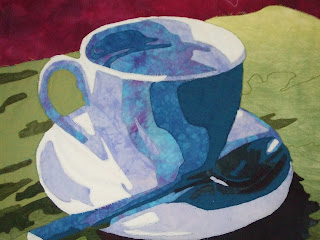It started when we harvested our Concord grapes and I saw all that beautiful purple juice. My husband was trying his hand at making grape jam, but all I could see was another way to dye fabric, so I confiscated some of the skins and juice and set about experimenting. My results, on cotton (left) and silk (right:
 |
| Dyed with grape skins and juice |
With this new passion ignited, I started looking for possibilities. Aha! Black walnuts from my son's backyard. When the outer hull (yellowish-green) begins to turn black and peel away, what's left is an inky black, fibrous substance surrounding the nutshell. It really stains! I filled a bucket with them, added water, stirred, and made "walnut hull stew" for fabric dyeing!
 |
| Walnut-hull stew |
I tightly bunched up a piece of cotton (pre-mordanted with alum), bundled it tightly, and tossed it into the "stew" for 24 hours.
 |
| Cotton, bundled for dyeing |
 |
| Walnut-hull dyed cotton |
 |
| Cotton sateen, walnut-hull dyed |
|
|
Because our summer seemingly lasted forever, I still had flowers blooming into late October, just as our trees were turning color and beginning to fall. My next experiments took me back to my childhood and my favorite library book,
Mud Pies and Other Recipes by Marjorie Winslow.* I walked through my yard, choosing flowers:
 |
| Late-season flower harvest |
I carefully picked apart the flower petals and leaves, then arranged them on lengths of alum-mordanted cotton and a piece of silk (no mordant) . . .
 |
| Flower petals and leaves on cotton |
Then tightly rolled each piece around a stick, secured with twine (also called "eco-bundling"):
Final step: placed them in a bamboo steam basket inside a very large pot, covered, and steamed for 1 hour.
Nothing happened. I missed a step! I forgot to mist them with vinegar water, so I did, and got them pretty wet, and steamed them for another hour. Here's one of the pieces after it air-dried.
But after I rinsed it in lukewarm water, most of the color faded and not much was left, except for the lines made by the twine wrapping:
Finally, I moved on to ice-flower dyeing, a method developed by
India Flint in her book
Eco-Colour. I used flower petals I'd collected during the summer, then placed in plastic bags and froze. I choose some frozen fuschia-colored peony petals, placed them in a Mason jar, and added lukewarm water (and vinegar, to promote the red color). According to India,
"the temperature shock of immersion assisted in the rapid release of colour.
Freezing plant material has the added benefit of breaking up the
structure of the plant, as the moisture contained within the
cells expands while becoming solid." (p. 138)
Unfortunately, my results were less-than stellar:
 |
Cotton, ice-flower dyed (with peony petals)
 |
Cheesecloth, ice-flower dyed (with peony petals). The pattern was created
by the way I folded the fabric before immersion. |
|
Where did the pretty color go? Looks like I'll need more practice!
Lessons learned: Patience is a virtue.
There are no guarantees in life. Keep playing and experimenting.
There's always more to learn.
* The magic of Mud Pies and Other Recipes: Though I didn't really play with dolls (except for Barbies), there was
something about foraging in my own backyard that totally absorbed me. At my pleading, my mom bought me a stack of 3x5"
index cards, and I hand-copied every recipe in that book for my own
collection. (Oh, how I wish I still had that collection!) I
can still recall the magical feeling evoked by
Erik Blegvad's
illustrations; they take me back to the smell and feel of bright, hazy
Mid-Atlantic mornings.
From the book's foreword:
This is a cookbook for dolls. It is written for kind climates and summertime.
It is an outdoor cookbook, because dolls dote on mud, when properly prepared. They love the crunch of pine needles and the sweet feel of seaweed on the tongue. The market place, then, will be a forest or sand dune or your own backyard . . .
















































